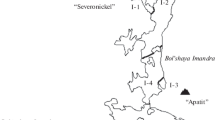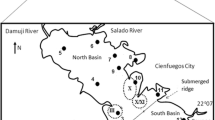Abstract
The distribution of essential elements (Са, Mg, Na, K, Zn, Cu, Mn, Co) in organs and tissues in basins with different water toxicity is considered by the example of bream Abramis brama L. The models of redistribution of essential elements in the liver and kidney of the fish are developed depending on the physiological state, which is estimated by the concentration of hemoglobin in blood, total disease, and body mass index. It is shown that essential elements can serve as markers of intensity and direction of metabolic processes in the fish organism.
Similar content being viewed by others
References
A List of Fishery Standards of Maximally Admissible Concentrations (MAC) and Approximate Safe Levels of Impact (ASLI) of Toxicants for Water of Aqueous Objects Having Fishery Significance (VNIRO, Moscow, 1999) [in Russian].
A. Kh. Agadzhanyan, Z. S. Minasyan, and Z. S. Zakharyan, “Regulation of activity of arginase in different organs of the European carp Cyprinus Carpio L.,” Biol. Zh. Armenii 56 (1–2), 37–41 (2004).
V. A. Aleshkin, L. I. Novikova, A. G. Lyutov, and T. N. Aleshkina, “Proteins of acute phase and their clinical significance,” Klinich. Meditsina 66 (8), 39–48 (1988).
V. V. Andreev and R. A. Guliev, “Sodium and potassium exchange in fishes at high ion concentration in water,” Vestn. Astrakhan. Gos. Tekhn. Univ. 44 (3), 43–48 (2008).
A. P. Avtsyn, A. A. Zhavoronkova, M. A. Rish, and L. S. Strochkov, Human Microelementosis: Ethyology, Classification, and Organopathology (Meditsina, Moscow, (1991) [in Russian].
A. Farkas, J. Salánki, and A. Specziár, “Age- and size-specific patterns of heavy metals in the organs of freshwater Fish Abramis brama L. populating a low-contaminated site,” Water Res. 37, 959–964 (2003).
Fish Physiology: Homeostasis and Toxicology of Essential Metals, Ed. by C. M. Wood, A. P. Farrell, and C. J. Brauner (Academic Press, San Diego, 2012).
N. A. Gashkina, Yu. G. Tatsii, V. N. Udachin, and P. G. Aminov, “Biogeochemical indication of environmental contamination: a case study of a large copper smelter,” Geochem. Int. 53 (3), 253–264 (2015).
M. Jonge, C. Belpaire, G. Thuyne Van, J. Breine, and L. Bervoets, “Temporal distribution of accumulated metal mixtures in two feral fish species and the relation with condition metrics and community structure,” Environ. Pollut. 197, 43–54 (2015).
E. Kerambrun, F. Henry, V. Cornille, L. Courcot, and R. Amara, “A combined measurement of metal bioaccumulation and condition indices in juvenile European flounder, Platichthys flesus, from European estuaries,” Chemosphere 91, 498–505 (2013).
L. T. Kirichek, and E. O. Zubova, “Molecular basis of oxidative stress and possibilities of its pharmacological regulation,” Int. Medical J., No. 1, 144–148 (2004).
O. N. Krylov, A Textbook on Prevention and Diagnostics of Fish Poisoning by Toxicants (Moscow, 1980) [in Russian].
J. Lee, M. M. Peña, Y. Nose, and D. J. Thiele, “Biochemical characterization of the human copper transporter,” Ctrl. J. Biol. Chem. 277, 4380–4387 (2002).
T. I. Moiseenko, “Ecotoxicological approach to water quality assessment,” Water Res. 32 (2), 163–174 (2005).
T. I. Moiseenko, “Hematological indices of fishes in the evaluation of their toxicoses with reference to Coregonus lavaretus,” J. Ichthyology 38 (2), 315–324 (1998).
T. I. Moiseenko and L. P. Kudryavtseva, “Ecotoxicological assessment of anthropogenic hydrogeochemical anomalies: an example being the Kola mining and metallurgical complex,” Geochem. Int. 37 (10), 1000–1017 (1999).
T. I. Moiseenko, N. A. Gashkina, Yu. N. Sharova, and A. G. Pokoeva, “Ecotoxicological assessment of aftereffects of the Volga River water contamination,” Water Res. 32 (4), 369–383 (2005a).
T. I. Moiseenko, N. A. Gashkina, L. P. Kudryavtseva, Yu. A. Bylinyak, and S. S. Sandimirov, “Zonal features of the formation of water chemistry in small lakes in European Russia,” Water Res. 33 (2), 144–162 (2006).
T. I. Moiseenko, L. P. Kudryavtseva, and N. A. Gashkina, “Assessment of the geochemical background and anthropogenic load by bioaccumulation of microelements in fish water,” Water Resour. 32 (6), 640–652 (2005b).
I. F. Pravdin, Manual on Fish Study (Pishchevaya Promyshlennost, Moscow, 1966) [in Russian].
G. G. Pyle, J. W. Rajotte, and P. Coutur, “Effects of industrial metals on wild fish populations along a metal contamination gradient,” Ecotoxicol. Environ. Saf. 61 (3), 287–312 (2005).
V. M. Sheibak, “Biologocal significance and regulation of zinc homeostasis of mammals,” Probl. Zdorov’ya Ekologii 50 (4), 11–16 (2016).
M. G. Skal’naya and A. V. Skal’nyi, “Trace elements: biological role and significance for medical practice. Communication 3. Manganese,” Vopr. Biol. Meditsin. Farmatsevt. Khimii, No. 3, 14–23 (2015).
K. F. Sorvachev, Biochemical Principles of Fish Feed (Legkaya Pishchevaya Prom., Moscow, 1982) [in Russian].
M. S. Tellis, D. Alsop, and C. M. Wood, “Effects of copper on the acute cortisol response and associated physiology in rainbow trout,” Comp. Biochem. Physiol., Part C 155, 281–289 (2012)
M. C. Vieira, R. Torronteras, F. Córdoba, and A. Canalejo, “Acute toxicity of manganese in goldfish Carassius auratus is associated with oxidative stress and organ specific antioxidant responses,” Ecotoxicol. Environ. Saf. 78, 212–217 (2012)
V. E. Volykhina, and E. V. Shafranovskaya, “Auperoxide dismutase: structure and properties,” Vestn. Voronezhsk. Med. Univ., 8 (4), 6–12 (2009).
L. D. Zhiteneva, T. G. Poltavtseva, and O. A. Rudnetskaya, Atlas of the Normal and Pathological Altered Cells of Fish Blood (Rostovsk. Kn. Izd., Rostov on Donu, 1989) [in Russian].
Author information
Authors and Affiliations
Corresponding author
Additional information
Original Russian Text © N.A. Gashkina, 2017, published in Geokhimiya, 2017, No. 10, pp. 934–941.
Rights and permissions
About this article
Cite this article
Gashkina, N.A. Essential elements in the organs and tissues of fish depending on the freshwater toxicity and physiological state. Geochem. Int. 55, 927–934 (2017). https://doi.org/10.1134/S0016702917100056
Received:
Accepted:
Published:
Issue Date:
DOI: https://doi.org/10.1134/S0016702917100056




